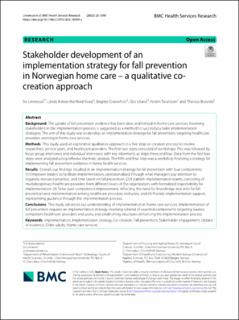| dc.description.abstract | Background The uptake of fall prevention evidence has been slow and limited in home care services. Involving
stakeholders in the implementation process is suggested as a method to successfully tailor implementation
strategies. The aim of this study was to develop an implementation strategy for fall prevention, targeting healthcare
providers working in home care services.
Methods This study used an explorative qualitative approach in a five-step co-creation process to involve
researchers, service users, and healthcare providers. The first two steps consisted of workshops. This was followed by
focus group interviews and individual interviews with key informants as steps three and four. Data from the first four
steps were analyzed using reflexive thematic analysis. The fifth and final step was a workshop finalizing a strategy for
implementing fall prevention evidence in home health services.
Results Overall, our findings, resulted in an implementation strategy for fall prevention with four components:
(1) Empower leaders to facilitate implementation, operationalized through what managers pay attention to
regularly, resource priorities, and time spent on fall prevention, (2) Establish implementation teams, consisting of
multidisciplinary healthcare providers from different levels of the organization, with formalized responsibility for
implementation, (3) Tailor dual competence improvement, reflecting the need for knowledge and skills for fall
prevention and implementation among healthcare providers and users, and (4) Provide implementation support,
representing guidance through the implementation process.
Conclusions This study advances our understanding of implementation in home care services. Implementation of
fall prevention requires an implementation strategy involving a blend of essential components targeting leaders,
competent healthcare providers and users, and establishing structures enhancing the implementation process. | en_US |

